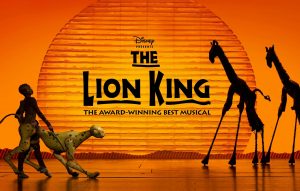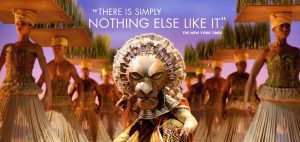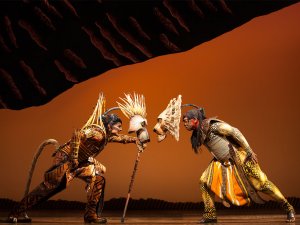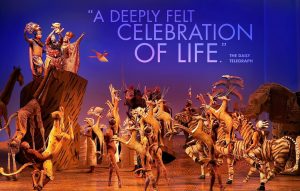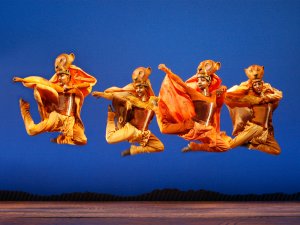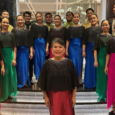A wreath of light rises onstage to crown the king, queen, and their newborn son. Rafiki heralds this occasion by belting out the first throes of the iconic Zulu chant at the beginning of “The Circle of Life,” announcing that the future king is here. All the animals in the kingdom gather together, prey and predator alike, and co-exist for one peaceful stretch of time to bow and venerate their would-be king.
This is how The Lion King begins, triggering the beginning of the very circle of life they sing of. Those who live in Pride Rock take the stage, animals of different shapes and sizes, all species coming together as one as the sun rolls out behind them. A proud king and queen present their son and The Lion King begins to unfold.
The Lion King was undoubtedly a hit when it first came out in 1994. It has captivated audiences far and wide with its story and its music. We don’t blame those who find themselves floored after seeing it. It didn’t take long for The Lion King to become a success onstage either and it has been widely regarded as the world’s #1 musical. And this title is definitely well-deserved.
I was on the edge of my seat from beginning to end. Not to be redundant, but the New York Times’ description is on point: “There is simply nothing else like it.” While the story was something I had been intimately familiar with (growing up a Disney kid and all), every turn of the narrative still swelled in my chest and brought me to tears or made me laugh. It was an experience for the entire spectrum of emotions.
The songs and scenes that aren’t included in the animated film are refreshing and add a new kind of energy to the entire musical. One in particular that stands out is after the 20 minute intermission when the birds all gather and sing. It puts you right back in the mood to watch and smile before plunging back to the story.
These new scenes create a consistent pulse all throughout, the ideas of circularity and repetitiveness to further emphasize that life happens in a circle. No scene is small and no interaction is easy to overlook because they are all set up with same kind of deliberate energy. Simple interactions are first laid out with a dance or song or the movement of puppets and the creative presentations for each movement onstage wowed us every single time.
The Lion King is a visual spectacle, arresting from beginning to end. The music is also on that same wavelength, of course, but there is definitely a different height that the visuals reach. Julie Taymor, the woman behind these designs, didn’t just translate the animated movie to fit the stage but she truly breathed new life into the narrative and re-imagined how she could present the story to audiences.
Taymor did not stray from her color and creativity, integrating different elements for different characters. Scar’s costume, for example, is meant to be spiny and creepy, as wicked-looking as he is with an asymmetric mask and everything. The lionesses are painted to be graceful but strong, their similar, sleek silhouettes differentiated by unique patterns to set them apart from one another while still underscoring their efficient fluidity as a group that hunts together.
Even the other animals have been conceptualized in fresh, beautiful ways. My personal favorites are all of the birds, how they were perched atop the heads of the actors or tossed across the audience on string and pole. They truly glide and captivate, as if they really were there with you. The gazelles and antelopes are ingenious, as well, how they are fixed to bicycles to imitate movement while retaining their graceful beauty.
And as if it wasn’t enough to have such beautifully-constructed costumes, each one also has details so intricate that you can only catch them when looking close enough. Elements of shadow plays are present throughout the musical and they’re also reflected in the costumes, the gaps often dressed with geometric shapes and negative space. This motif ultimately ties everything together, creating a coherence all throughout the show.
It isn’t just the costumes, of course, but the set, too! When depicting movement, sometimes the background is used with lights and puppets, all cut in beautiful angles and shapes but still very much representative of the characters. Scar’s puppet is angular and sharp, Simba’s is small and playful. Even in the tiniest of details can we see how the visual also demonstrates character and shows off an understanding of each character’s personality.
And while the story is one that many of us already practically memorize, it’s interesting to see how this re-imagining also changes the nuances of each character’s actions and motivations. The symbolic gravity behind staying in Pride Rock despite everything turning out for the worse under Scar’s rule is somehow heavier when Sarabi and the other lionesses confront him about there being no more food.
Scar is so obsessed with being king of Pride Rock that it doesn’t count for him to move elsewhere. He needs that symbolic grasp, he needs to be the king of the place that he felt robbed from him and nowhere else even if it meant the possible extinction of the pride he was meant to be leading and protecting. Moving elsewhere will actually leave him with a kingdom to lead and govern while staying means starving and death. But he doesn’t see past his stolen crown and imagined kingdom.
Which brings the idea of pride at all into question. A group of lions is called a pride and the other meaning of this word plays into the entire play. The way that Mufasa is proud differs greatly from the way Scar is. Scar is a stubborn kind of pride while Mufasa is proud because of what he has achieved. And this is where sensibilities clash and conflict begins, Scar’s indignation rooted in how his strengths were not rewarded because he wasn’t brutish and strong like his brother. Ultimately, however, he still loses the throne, Pride Rock, and his supporters.
The musical ends with Simba being re-absorbed into the kingdom and given the throne he was promised. The animals all come out like in the opening, gathering ’round Pride Rock to bow. The opening and ending are almost identical, what with Rafiki now presenting Simba’s son to the kingdom and everyone bowing to him. And the fact that it starts the way that it ends ties seamlessly into the theme of repetition, of circularity. It truly is a circle of life, one that each character traverses in their own time.
The Lion King is an absolute delight to witness. Moving, innovative, and lots of nostalgic fun, you really don’t want to miss out on it!
You can catch the show here in Manila until April 17 at The Theatre in Solaire.
What are you looking forward to the most in The Lion King? Let us know!

